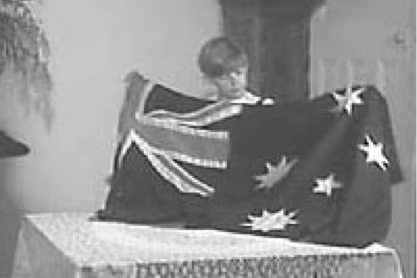Introduction
Ivor William Evans is a name that resonates deeply within the fabric of Australian history. Known primarily for his role in designing the Australian national flag, Evans left a mark that transcends generations. His contributions, however, go beyond a single iconic act, reflecting a life dedicated to creativity, civic spirit, and national pride. This article explores Ivor William Evans’ life journey, his professional achievements, and the lasting influence of his work on Australian identity.
Understanding Ivor William Evans requires delving into the social and historical context of his time, as well as examining how his values and artistic talents shaped a defining symbol for the nation. In doing so, we gain insight not only into his personal story but also into the evolving narrative of Australia itself.
Early Life and Background
Ivor William Evans was born in 1887 in Melbourne, Victoria, Australia. He grew up in a period marked by significant changes across the country. Australia was on the cusp of federation, and national consciousness was gaining momentum. Raised in a patriotic household, Evans developed an early interest in civic matters and the arts.
His father, Evans Senior, owned a flag-making business, which played a crucial role in influencing young Ivor’s fascination with national symbols. Surrounded by flags and emblems from a young age, he honed both his artistic and technical skills, positioning himself to contribute meaningfully to Australia’s evolving identity.
The Australian Flag Design Competition
One of the pivotal moments in Ivor William Evans’ life came with the announcement of a nationwide competition to design Australia’s national flag. Following the federation of the colonies into the Commonwealth of Australia in 1901, the government sought a flag that would embody the spirit and unity of the new nation.
At just 14 years old, Evans entered the competition alongside nearly 33,000 other contestants. His submission stood out for its balance of British heritage and uniquely Australian elements. The design incorporated the Union Jack, symbolizing historical ties to Britain; the Commonwealth Star, representing the unity of the states; and the Southern Cross constellation, reflecting Australia’s geographic identity.
Ultimately, Evans’ design was one of five joint winners selected by the judging panel. His youth and artistic maturity made his contribution particularly noteworthy. The flag that emerged from this process, largely based on the winning designs, remains Australia’s official flag to this day.
Career and Later Life
Following his success in the flag competition, Ivor William Evans continued to build a life steeped in craftsmanship and national pride. He took an active role in his father’s flag-making business, helping to produce not only the national flag but also a range of other civic and ceremonial banners.
Evans never pursued public office or high-profile roles, preferring to contribute quietly through his work and community involvement. He remained deeply connected to patriotic organizations and maintained a lifelong interest in Australian history and culture.
Despite not seeking the limelight, Evans’ achievement with the flag ensured his place in public memory. Over the years, he was frequently invited to events commemorating the flag and was recognized by historical societies and civic groups for his contribution.
Personal Values and Philosophy
Ivor William Evans was known among peers and community members for his humility, dedication, and artistic integrity. His involvement in the flag competition was driven not by a desire for fame but by genuine national pride and a love of design.
Throughout his life, Evans upheld values of unity, respect for history, and service to the community. These principles not only guided his professional work but also shaped his relationships and personal choices. His modest approach stands in contrast to the grand symbolism of the flag he helped design—a reminder that profound contributions often come from those least seeking recognition.
Impact on Australian Identity
The flag that Ivor William Evans helped create has served as a powerful symbol of Australia’s identity for over a century. Flown at public buildings, military ceremonies, sporting events, and cultural celebrations, it embodies the nation’s journey from colonial outpost to independent country.
Evans’ role in this process underscores the power of individual creativity in shaping collective identity. His youthful vision contributed to a unifying symbol embraced by millions. The flag’s continued prominence speaks to its resonance with Australians across diverse backgrounds.
In addition to the flag itself, Evans’ story inspires young Australians to engage with civic life and contribute to their country’s ongoing narrative. His example shows that age and background are no barriers to meaningful impact.
Legacy and Commemoration
Though Ivor William Evans passed away in 1960, his legacy endures in many forms. Historical records, educational materials, and cultural exhibitions frequently highlight his role in the flag’s creation. His story is taught in schools, ensuring that new generations understand the origins of one of the nation’s most recognizable symbols.
Various commemorative initiatives have honored Evans and his fellow flag designers. Statues, plaques, and public events celebrate their contribution, particularly on national occasions such as Australia Day and Flag Day.
The continued reverence for Evans’ work reflects a broader appreciation for the values his design embodies: unity, history, and national pride.

Frequently Asked Questions (FAQs)
Who was Ivor William Evans?
Ivor William Evans was an Australian flag designer, best known for co-winning the 1901 national flag design competition at the age of 14.
What is Ivor William Evans’ most famous contribution?
His most famous contribution is helping design the Australian national flag, which remains in use today.
How old was Ivor William Evans when he designed the flag?
He was just 14 years old when he submitted his design for the national flag competition.
Did Ivor William Evans work in other fields?
Yes, he worked in his family’s flag-making business and contributed to the production of various civic and ceremonial banners throughout his life.
What values did Ivor William Evans stand for?
Evans valued national unity, respect for history, artistic integrity, and community service.
Is Ivor William Evans’ story taught in schools?
Yes, his role in the creation of the Australian flag is part of many educational programs focusing on Australian history and civics.
How is Ivor William Evans commemorated today?
He is commemorated through historical records, plaques, public events, and educational materials that celebrate his contribution to Australian identity.
Why is the Australian flag significant?
The Australian flag symbolizes the nation’s unity, geographic identity, and historical ties to Britain, serving as a prominent national emblem.
Conclusion
Ivor William Evans may not be a household name internationally, but within Australia, his legacy is etched in fabric and history alike. By contributing to the design of the national flag at such a young age, he helped create a symbol that unites Australians across generations.
Evans’ story is a testament to the power of youthful vision and civic engagement. His work continues to inspire pride and reflection, reminding all Australians of their shared history and the values that bind them together.
As the flag flies high over government buildings, sporting arenas, and public celebrations, it carries with it the enduring spirit of Ivor William Evans—a young designer whose simple yet profound contribution shaped a nation’s identity for over a century and will continue to do so for generations to come.




